Just back from my 2019 Hokkaido Landscape Photography Adventure Tour & Workshop, today we start a three-part travelogue series with a total of 30 images over the next three weeks to illustrate our adventure.
[download id=”55600″]
As usual, we kicked off this year’s tour in the picturesque Biei area, with its beautifully situated trees that decorate the rolling snow-covered hills. It’s often hard to understand without seeing the difference, but the grey sky that you see in this first image from Biei is what really makes these images possible.
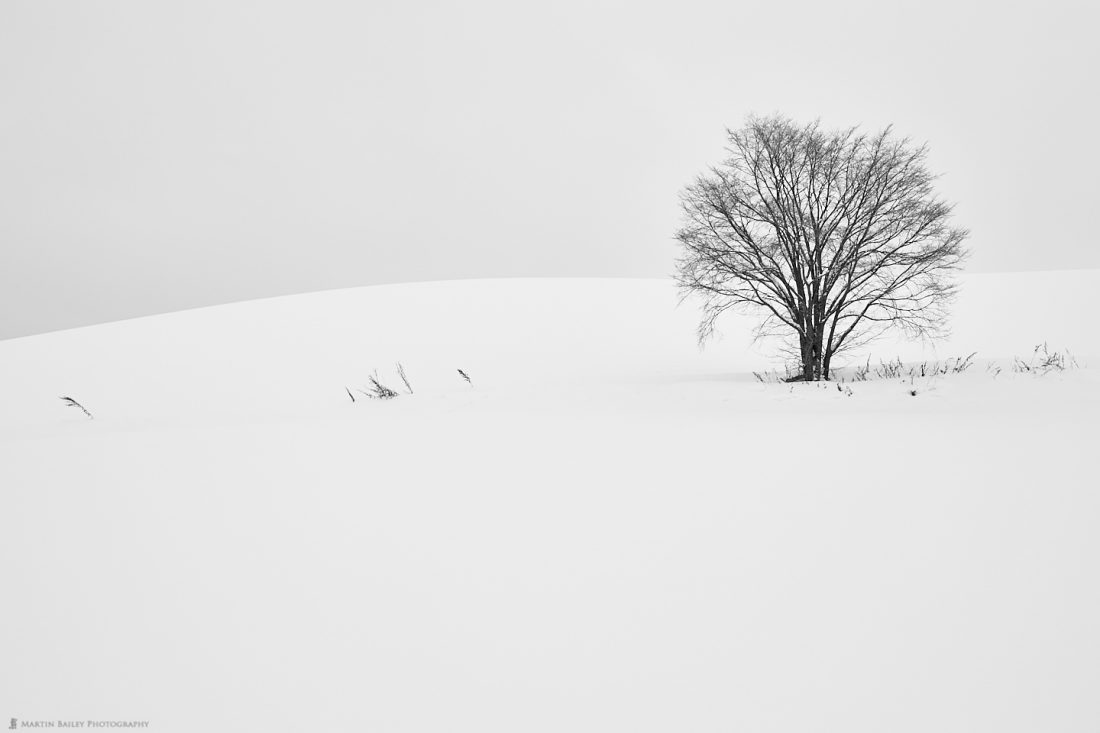
In the sun, the contrast is too great, and we get harsh shadows under the trees and from the grasses, and it is, in my opinion, much less pretty then. I love the almost complete lack of shadows from the grasses, and the very subtle, soft shadow that we get under the trees.
Most years, we actually have so much snow that the grasses don’t show through like this, but with relatively little snow this year, many were poking through, and they made for nice additional elements to punctuate the scenes that we shot.
I shot this image at f/14 for a 1/25 of a second at ISO 100, and a focal length of 67mm with the new Canon RF 24-105mm f/4 lens.
Canon EOS R
Apart from a few test shots, I shot this entire trip with the new Canon EOS R mirrorless camera, and I have to tell you, that at this point, I’m very happy with it. I’m going to do a full review later after I’ve seen how well it handles fast-paced wildlife shooting, but for Landscape, it was an absolute pleasure to work with.
There were a few problems, like not being able to see the border around the histogram on the LCD in bright conditions, but nothing that I would consider really major, and the image quality is absolutely stunning.
Hut and Tree
We travel in a large bus so that everyone has a double seat to themselves, and at this location, shortly after photographing the tree in the previous image, I had our driver drop us off along a road in the hills, from where we just walked in short bursts while photographing the various things that we can see from the road, such as this hut with a small tree.
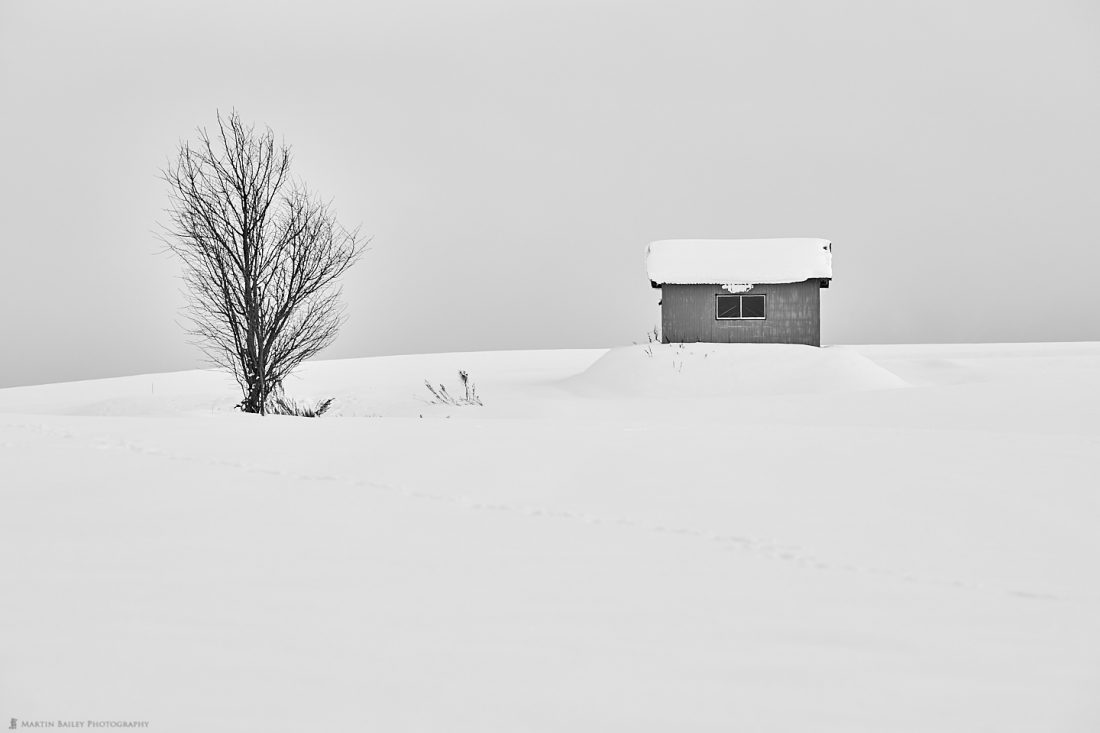
I love the mound of snow that the hut is perched on, and again the grasses that are poking through the snow. I also find the footprints that run diagonally through the snow from right to left appealing, and again, the subtle difference between the snow and the grey sky is something that I love to shoot.
I’m doing all of my processing in Capture One Pro, including flicking on the Black and White checkbox to completely remove the color, but there really isn’t a lot of difference. The original scene had hardly any color in it anyway. My settings for this were f/11 for a 1/30 of a second at ISO 100, at 255mm with my EF 100-400mm Mark II lens.
Copse and Hills
The minimalism of this next shot really appeals to me as well, with the
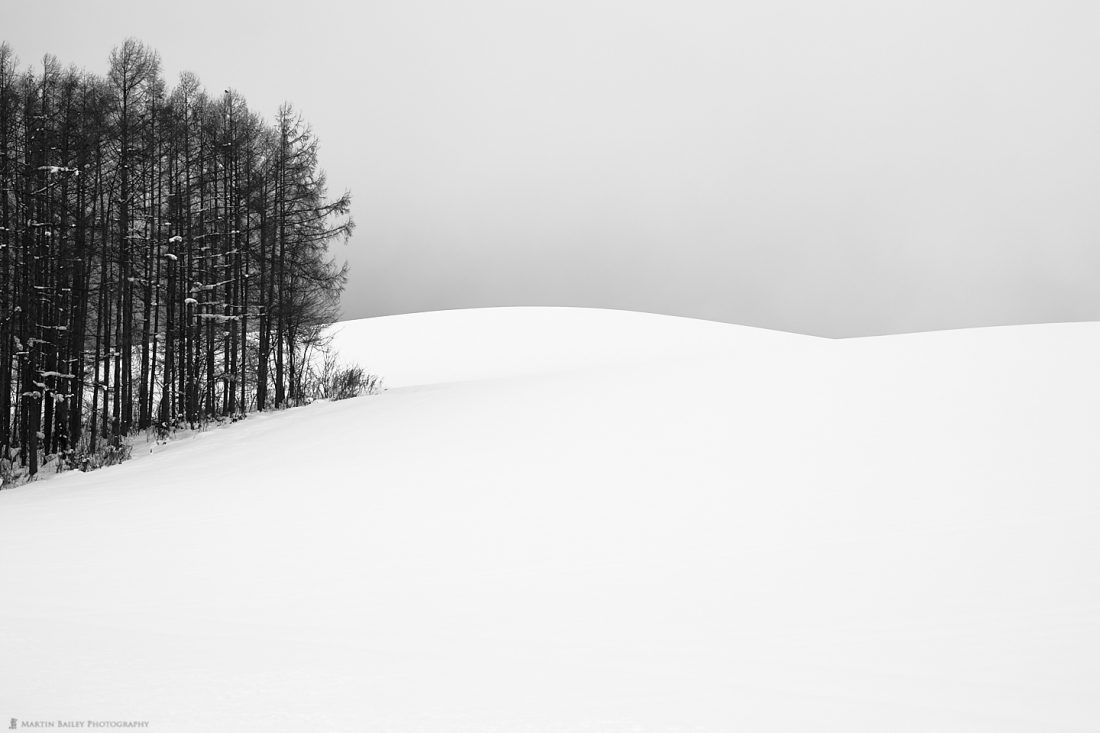
I actually adjusted the mid-tones with the Levels sliders in Capture One Pro to darken the sky down a shade or two to accentuate the curve of that middle distant hill, as it extends left behind the trees. My settings for this image were f/14 for a 1/50 of a second at ISO 100, at 74mm, again with the new RF 24-105mm lens.
Patchwork Snow
Having less snow than usual presented us with an unexpected gift as the snow started to fall and we headed behind the Takushinkan Gallery to photograph the line of trees there.
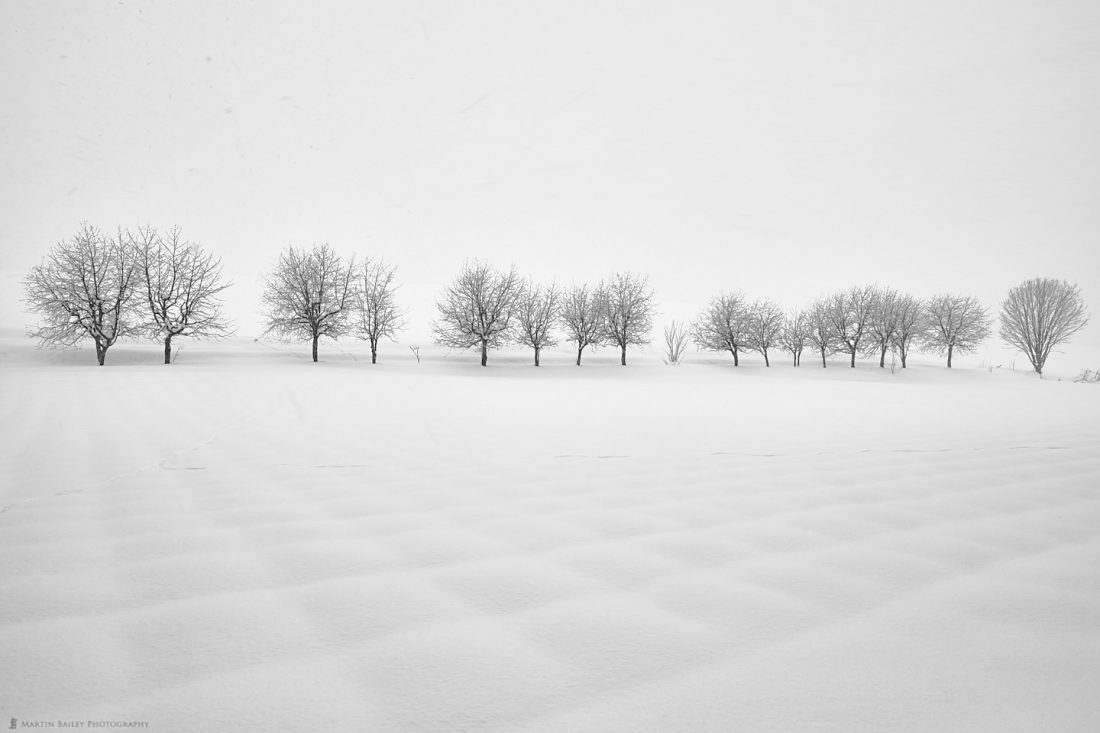
You might also be able to make out the flakes of snow more visible in the sky than the foreground, but it was falling quite heavily when I shot this, so I was doing my trick of blowing
My settings here were f/11 for a 1/20 of a second at ISO 100, and a focal length of 22mm with my 11-24mm f/4 lens. I like to use a long shutter speed for this kind of shot to cause the snow to streak a little bit as it crosses the front of the trees.
Snow Pillows
On our third day in Biei, we drive around to the ski slopes at Mount Asahi, where I used to enjoy photographing the pillows of snow that form on the rocks in the river before we start to drive up the mountain. For the last few years, they’ve been building a new bridge and the conditions haven’t been great, but this year, the bridge is finished, and we had some lovely snow pillows again, as you can see in this next image.
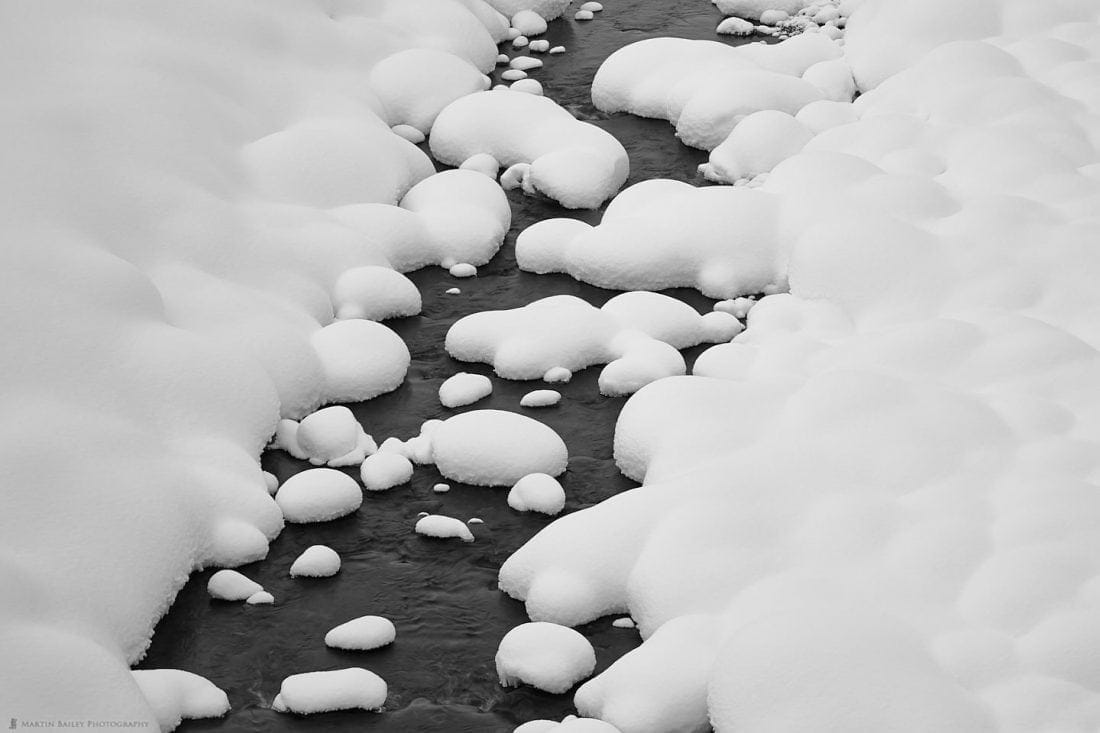
I’ve chosen a landscape oriented image as it works better for the blog, and I like how we can see the pillows of snow extended up the banks where the snow has completely covered the river.
Because I always expose to the right, which is especially important when photographing snow scenes, the snow requires a Luma tone curve with a small dip in the slightly darker snow to bring out the very subtle tonal differences. The selected node in this tone curve screen capture is the one responsible for this adjustment.
My settings for this image were f/14 for a 1/4 of a second at ISO 125, at 105mm. The ISO of 125 was accidental. The new RF lenses from Canon have a control ring on them that I have programmed so that I can turn it to change my ISO, but I must have caught it as I adjusted the lens, and didn’t notice until after I’d shot these images.
Mount Asahi Big and Small Trees
After photographing the Snow Pillows, we headed up the mountain and parked in the cable car station car park, then walked a little way up the ski slope to photograph the trees in the snow there. This is another one of my favorite spots from this trip, although it can be tricky to compose as it’s difficult to decide where to start and where to end your frame.
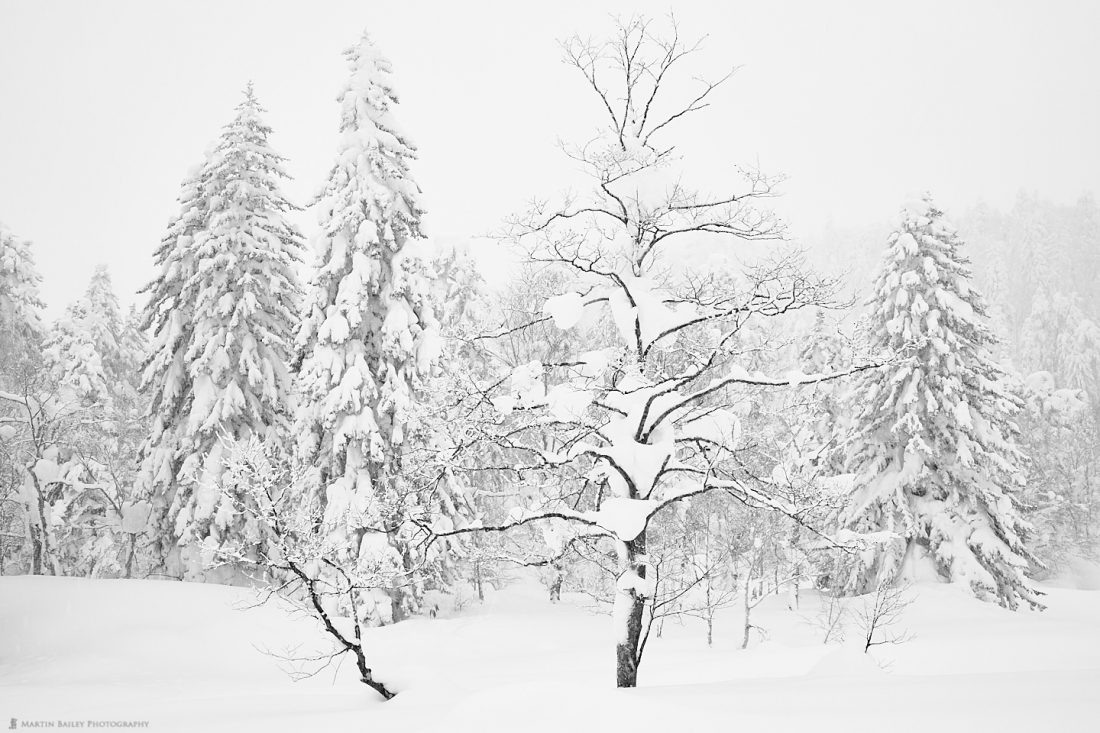
One of my favorite trees is this one with the dark bark, which provides a beautiful contrast against the snow piled up on its branches, and there is a smaller tree now growing next to it. I positioned myself so as to get the Christmas trees in the background nicely framing the foreground dark tree, and left just a little more space either side of these. I shot this at f/14 for a 1/30 of a second at ISO 100, and a focal length of 47mm.
I have another composition that I like to shoot here, but I’ve shared that many times, and on this trip, I actually shot that composition with both the EOS R and my 5Ds R so that I could do a print comparison later.
Sneak Preview
In fact, as a bit of a sneak preview, here is a screenshot of both the 5Ds R and the EOS R versions of the same photograph, both zoomed in to 100% so that you can see the difference between the two camera’s image quality. The 5Ds R shot is on the top and the EOS R shot is on the bottom.
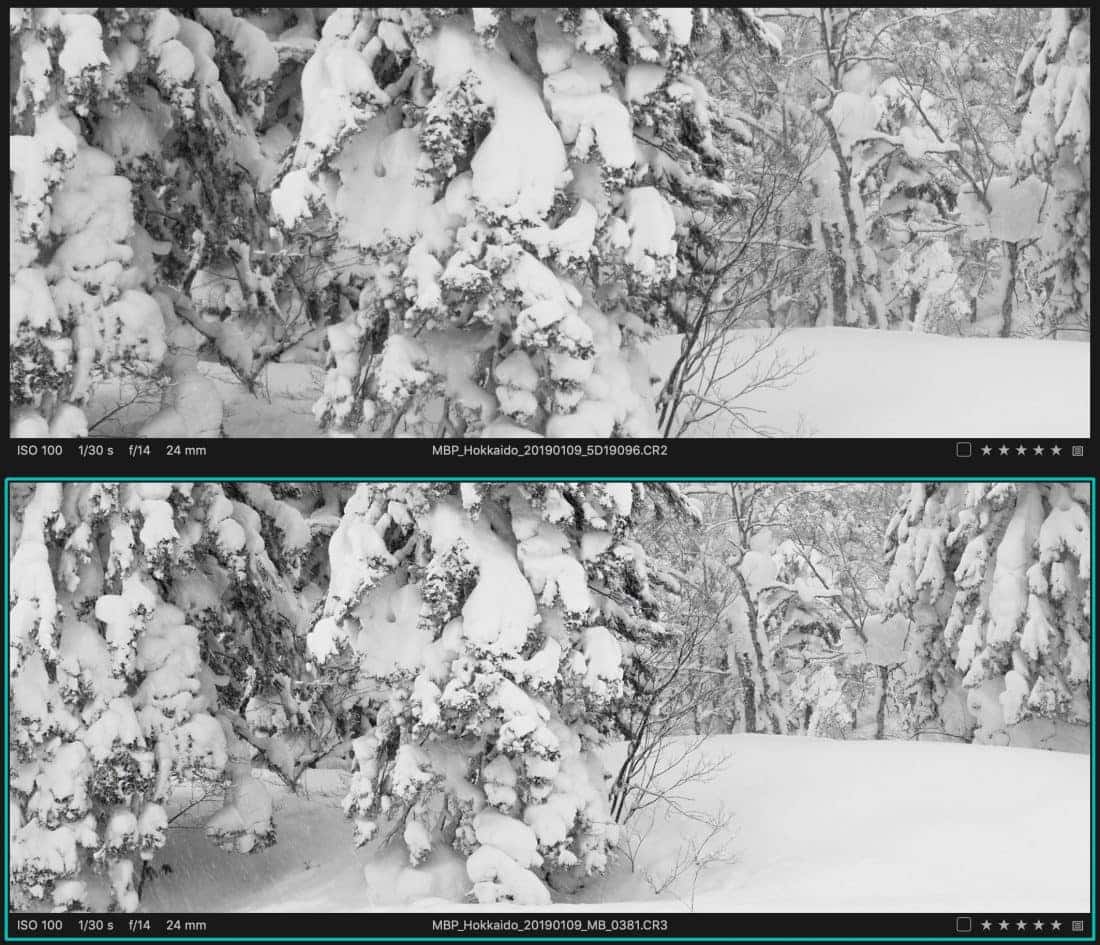
The 5Ds R is obviously zoomed in more because it’s a 50-megapixel file compared to the 30 megapixels of the EOS R, but I think you’ll still agree that the EOS R with the new RF 24-105mm lens has the edge. It’s slightly sharper with more defined edges. You might need to click on the image and open it up in the lightbox to view the details.
Enchanted Forest
This next photograph seems like a scene from Narnia to me, almost like an Enchanted Forest. There is a stream that runs through the trees here, but it’s almost completely covered in snow, forming this zigzag of huge snow pillows.
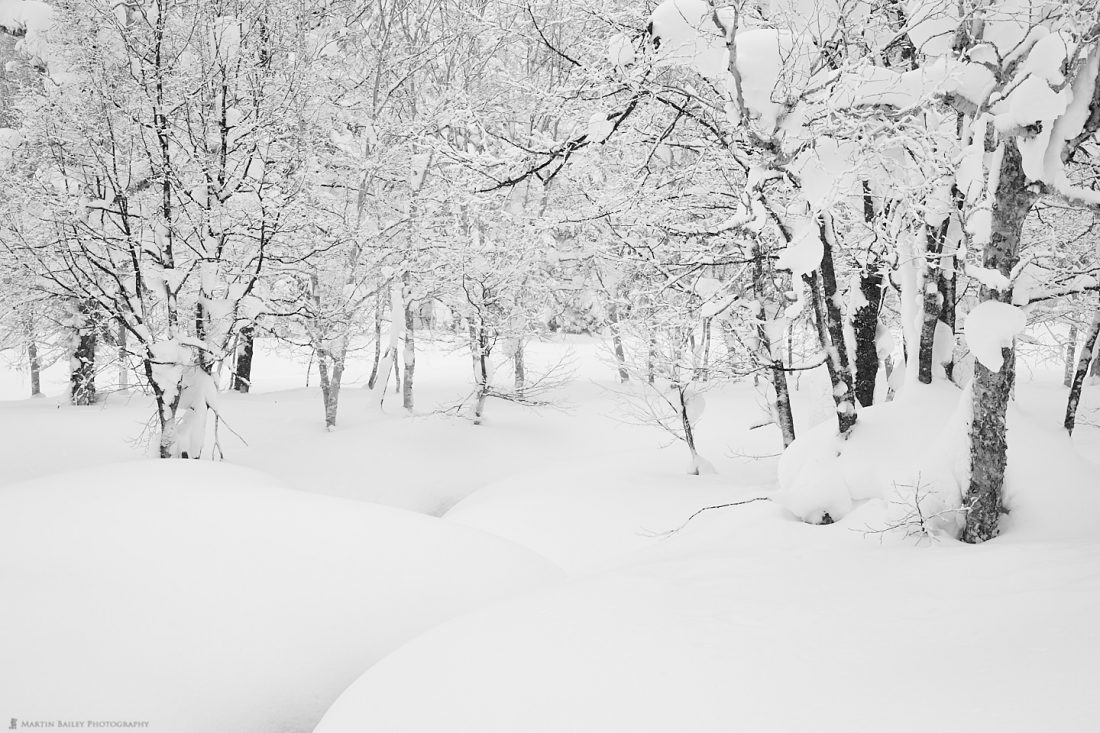
Again, I’m attracted to the darker trees and how they contrast with the snow, but also here the lighter birch trees add a subtle extra element of contrast. My settings for this were f/14 for a 1/30 of a second with ISO 100 and a focal length of 70mm.
New Opportunities
As I mentioned, there was less snow in the lower hills around the Biei area, and although this can be trickier to work with, as usual, it presented us with some new opportunities, as in this photograph, where the lines of grasses and smaller trees that are usually buried, are forming lines, working their way through the snow.
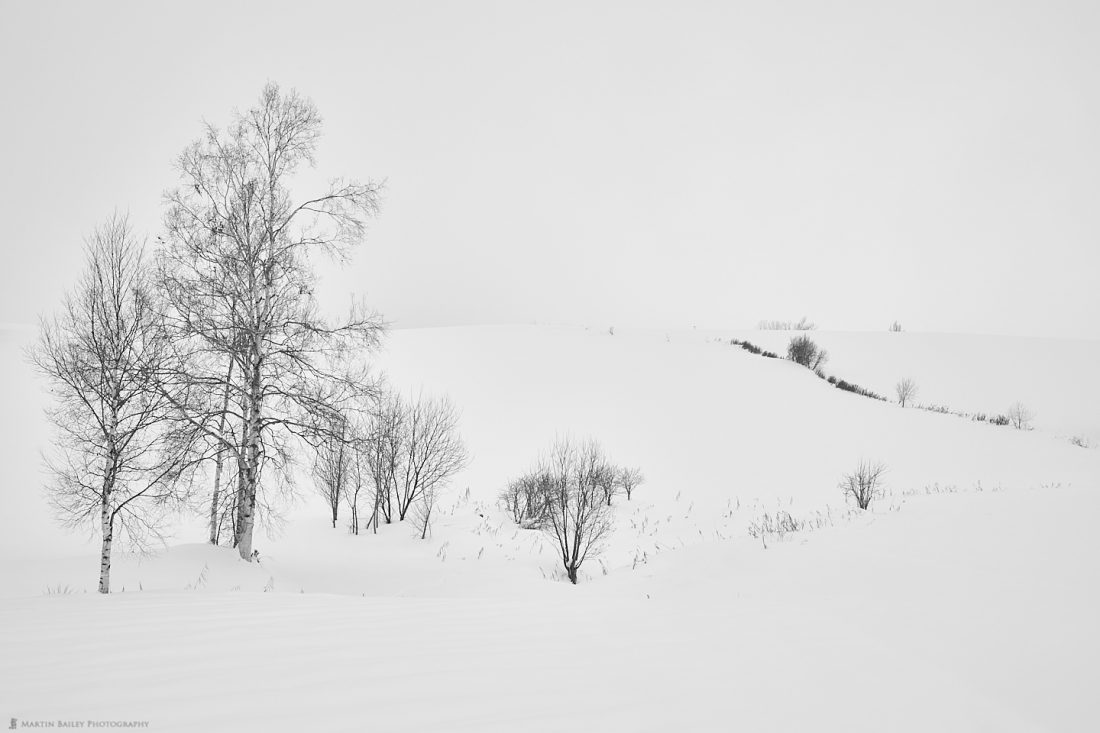
For some reason, in this shot, they remind me of a trail of gunpowder, as though someone is plotting to blow up the foreground tree and has run a trail of gunpowder into the distance. There are also plow lines in the foreground snow, again, something that we would not usually be able to see.
I was shooting with an aperture of f/14, a 1/15 of a second exposure at ISO 100, and a focal length of 50mm. With such a slow shutter speed, you can probably appreciate how little the light was
Copse in Hills
This next image is a take on a subject that I haven’t photographed for a while. When the snow comes in, it completely obscures the distant mountains that are usually visible behind this copse in the hills of Biei, completely minimalizing the scene.

I’ve used the Levels sliders to bring out the tones a little and darken down the trees adding contrast to the image, and I really like how we can again see the plow lines under the snow. My settings for this image were f/14 for a 1/4 of a second at ISO 100, with the lens zoomed all the way in to 105mm.
Embarrassing Moment
I actually had a
I had to laugh at myself though when I realized that I’d just found out that the EOS R has focus peaking, where things in focus are outlined in red, but this only kicks in when using Manual focus, so I’d not seen it before. It’s a very useful feature, but it’s somewhat embarrassing to have thought I was seeing the warm glow of a sunset in the middle of a snowstorm.
Shirahige Falls
Behind the hotel that we stay in during our three days in Biei, there’s a waterfall called the Shirahige Falls. The water that flows through the falls and river below has a slight blue tint due, I believe, to the mineral content, so it adds a nice splash of color to this magical winter scene. I’ve enhanced the blue slightly here to increase the color contrast.
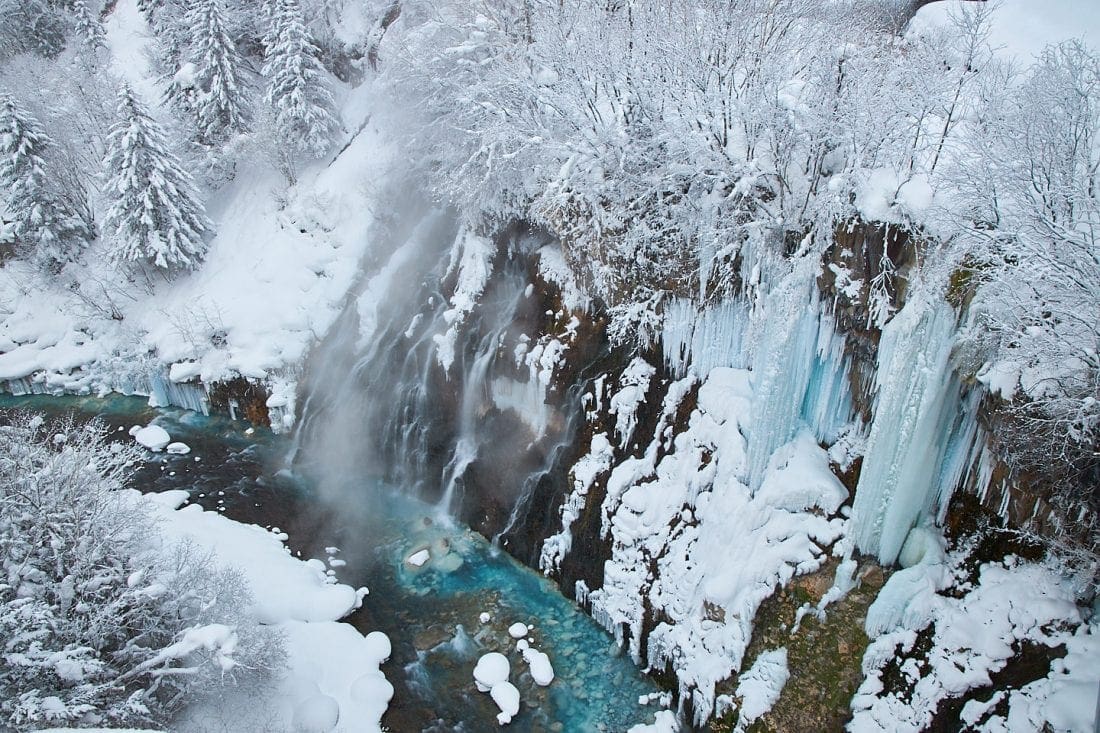
This is actually the first time in many years that I’ve shot these falls in their entirety. I usually zoom in much tighter, but the huge icicles to the right of the falls were appealing, and I also liked the trees framing the falls here, so I opened up the lens to 24mm for this image. My other settings were f/14, for 0.4 seconds at ISO 160.
This time I’d moved my ISO on purpose, to avoid having too long a shutter speed, which records more movement in the mist from the water, and that reduces the clarity of the falls.
OK, so that’s our ten photos for this first travelogue episode, and I slipped in a few bonus screenshots, so we’ll wrap it up there for this week. I’ll be back next week with the second part of this series, as we leave Biei and head over to the west coast of Hokkaido.
Show Notes
Buying with our B&H Photo Affiliate links helps to support the podcast at no additional expense to you. Thank you!
Canon EOS R: https://mbp.ac/eosr
Canon RF 24-105mm Lens: https://mbp.ac/rf24-105
Audio
Subscribe in iTunes to get Podcasts delivered automatically to your computer.
Download this Podcast as an MP3 with Chapters.
Visit this page for help on how to view the images in MP3 files.

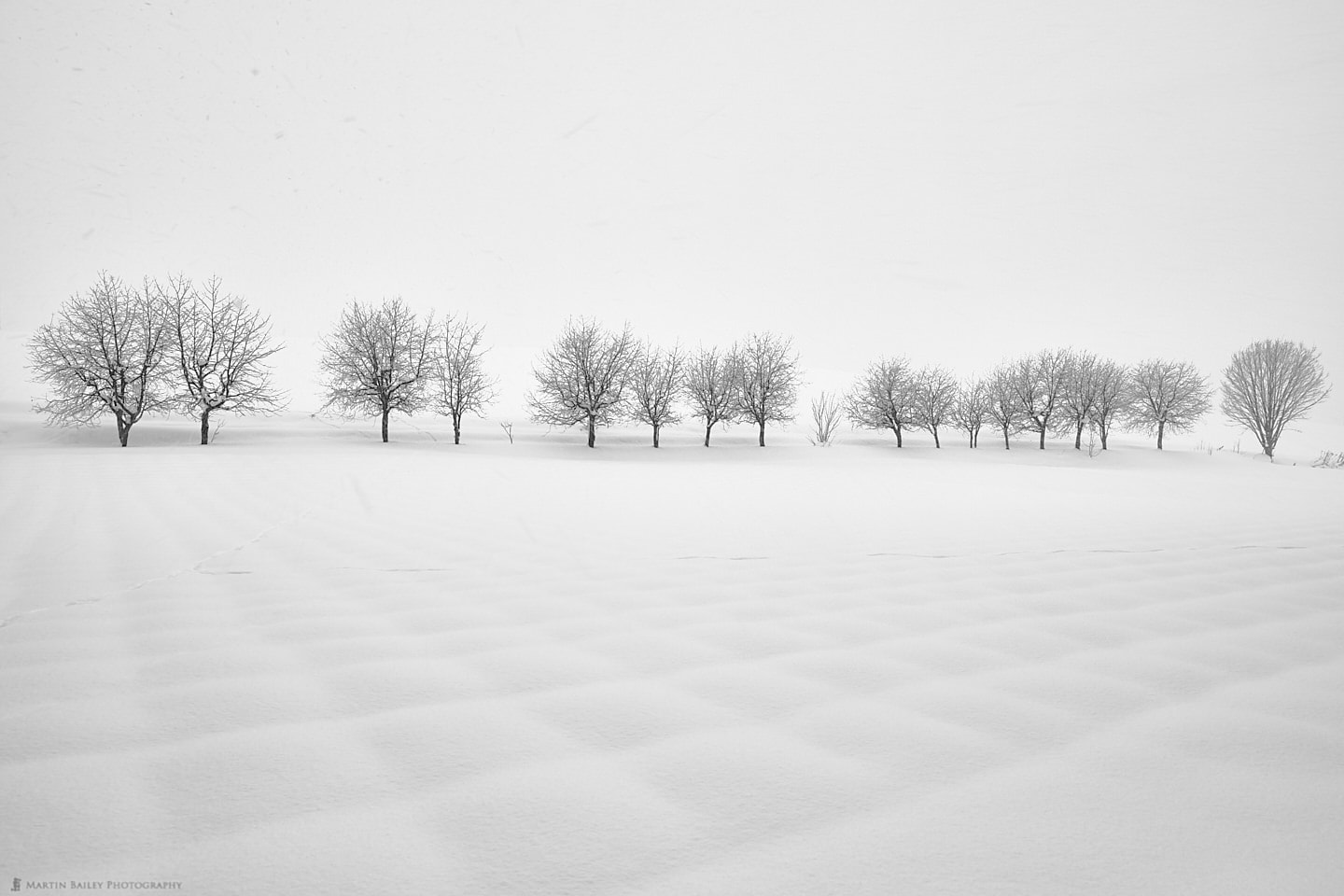
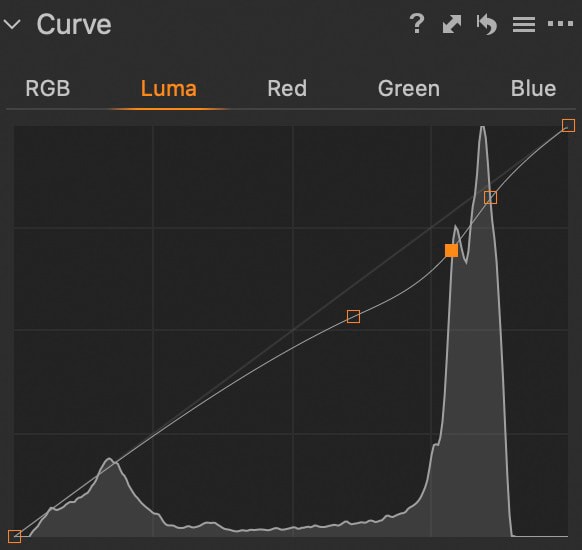

Martin, as a member, I downloaded the eBook version of this post and was sad to discover that the formatting breaks up your beautiful horizontal images into two separate vertically formatted pages. Is this something you can fix? Otherwise your posts are better to view in the online version, reducing some of the value of the membership.
Hi Chris,
Please read the instructions here: https://mbp.ac/pdf
The book is designed for maximum flexibility, but you have to change the settings to view the double page spreads.
I’ve found the best way to view is using the Mac OS X Preview app. Just open the PDF with the Preview app, then hit the CTRL + COMMAND + F keys to go to full screen, and press COMMAND + 3 to show the two page spreads, and navigate between pages with the arrow keys.
The eBooks look great in Preview, as well as the other apps I mention on the above help page.
Please let me know if you continue to have problems and thanks for subscribing!
Regards,
Martin.
Thanks Martin. I got the Goodreads app and it’s working as you said. Problem solved.
Good to hear. Thanks for the update Chris, and again, thanks for subscribing!
I hope you enjoy the ebook articles.
Dear Martin. These images are magnificent. It is disappointing that I was not able to join you on this workshop but I am hoping to get some equally stunning landscape opportunities during our wildlife workshop next month. Regards, Yvonne
Thanks Yvonne!
Sorry we weren’t able to accommodate you the Landscape Tour. Please don’t get your hopes up too much for landscape work on the wildlife tour though. We travel in different parts of Hokkaido and the priority is on Wildlife. There will be a few Landscape opportunities, but it’s not really like the Landscape Tour. That’s why they are separate tours.
Regards,
Martin.
Hi Martin. I am equally eager to photograph the wildlife. It is a compliment to your images that you make the landscape so enticing.
Regards, Yvonne
Thanks Yvonne!
I have always dismissed drones as something separate from photography until the travel-sized Mavic 2 Pro with its 1″ sensor came out last summer. Now I look at scenes like the last one in this post and see tremendous possibilities with what is essentially a flying camera. I don’t own one (yet) but if I did I would definitely have pulled it out to drop down into that canyon for a cool perspective—assuming the rules allow for it.
You have a good eye for a shot Tim.
We did just that for my Hokkaido Tour video that we created two years ago, and you can see the footage interspersed in the video here:
https://mbp.ac/572
Regards,
Martin.
Cool! I obviously missed that but I’ll check it out now. Thanks, Martin.
Hi Martin,
I heard you mention on the podcast you were having problems seeing the edge of the histogram on your new camera.
If it’s any help, I used to have the same problem on my EOS 60D when I started exposing to the right after your advice.
My solution was a very narrow strip of duct tape stuck on the screen in line with the end of the scale. It doesn’t interfere with the display in any way that causes me a problem and can be seen in the brightest sun light, when the histogram is only just visible.